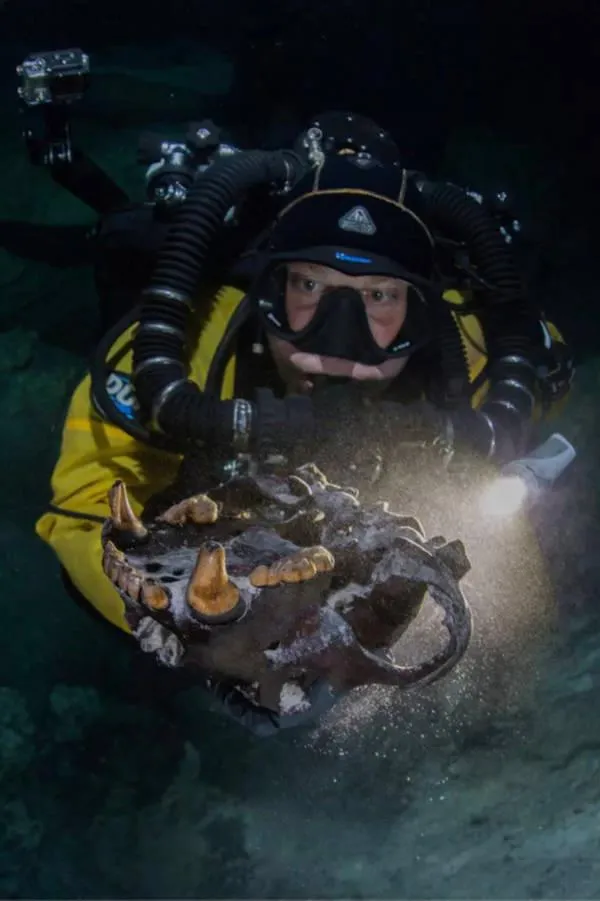Divers Find Ice Age Megafauna Remains in Underwater Mexican Cave
The animals include at least seven short-faced bears and one or two wolf-like carnivores
/https://tf-cmsv2-smithsonianmag-media.s3.amazonaws.com/filer/72/d2/72d2128d-299a-44ca-8c09-f83052d49ec9/5cc850a82400008b00e51b0a.jpg)
Short-faced bears, wolf-like carnivores, saber-toothed cats and elephant relatives known as gomphotheres are among the Ice Age creatures whose fossilized bones have been recovered from a submerged cave in Mexico’s Yucatán Peninsula. Known as Hoyo Negro, or “black hole” in Spanish, the cavernous, 200-foot pit lured unsuspecting ancients to their deaths, entrapping humans and animals alike in a dark cave system that eventually flooded and preserved their remains.
As researchers led by Blaine Schubert of East Tennessee State University report in the journal Biology Letters, the trove includes bones dating to between 38,400 to 12,850 years ago—a period encompassing much of Earth’s last Ice Age and the latter end of the Late Pleistocene Epoch. Although the majority of the fossils were retrieved from Hoyo Negro years ago, Schubert tells Live Science’s Laura Geggel that some were previously misidentified. The short-faced bear, Arctotherium wingei, for example, was erroneously placed in the genus Tremarctos, while the wolf-like Protocyon troglodytes was labeled as a coyote species, Canis latrans.
According to Schubert, the latest study builds on new analysis and subsequent excavations to set the record straight. Thanks to the discovery of at least seven short-faced bears, as well as the remains of two potential canids, the team now has a clearer picture of the animals’ geographic reach. Popular Mechanic’s David Grossman notes that the bear species, which boasts an upper weight limit of 3,500 pounds, is estimated to be the largest bear known to science.
“The whole previous record of this particular type of bear is just known from a few localities in South America, and those are fragmentary remains,” Schubert says. “So, we went from not having any of this type of bear outside of South America to now having the best record of this type of bear from the Yucatán of Mexico.”

Bears and wolf cousins aren’t the only animals catalogued in the study: As George Dvorsky writes for Gizmodo, the researchers also identified tapirs, cougars, dog-like animals, and multiple ground sloth species, including the newly described Nohochichak xibalbahkah. Unlike most animal bones dating to Central America’s Late Pleistocene period, these remains—protected from the tropical climate by Hoyo Negro’s low-oxygen flood waters—are remarkably well-preserved.
In 2007, divers exploring the underwater network unearthed the remains of an adolescent female who lived between 12,000 and 13,000 years ago. According to Yahoo News’ Will Metcalfe, the prehistoric girl, dubbed Naia, likely fell into the pit after entering the cave system in search of fresh water. Her bones, as well as those of at least 28 animals discovered to date, remained hidden in the depths for millennia.
Live Science’s Geggel notes that the new research further adds to scientists’ understanding of the Great American Biotic Interchange (GABI), which found plants and animals crossing over from North to South America—and vice versa—around 2.5 to three million years ago. The North American short-faced bear likely followed this path, with some members of the species opting to remain in Mexico during the journey south, or perhaps recrossing a land bridge from South to North America at a later time.
“We had no record of these animals making it back across that isthmus again until now,” Schubert tells New Scientist’s Chelsea Whyte.
Interestingly, Schubert and his colleagues posit that the number of glacial pulses, or ecological shifts, linked with GABI may stand at five rather than four. Occurring “at, and as a result of, the end of the last Ice Age,” in the words of Gizmodo’s Dvorsky, the fifth pulse would have triggered landscape changes and migration opportunities much like the previous four. Unlike these earlier incidents, however, the study’s authors write that the last wave would have “involved humans and culminated with the mass extinction of most American megafauna, including Arctotherium and Protocyon.”
/https://tf-cmsv2-smithsonianmag-media.s3.amazonaws.com/accounts/headshot/mellon.png)
/https://tf-cmsv2-smithsonianmag-media.s3.amazonaws.com/accounts/headshot/mellon.png)